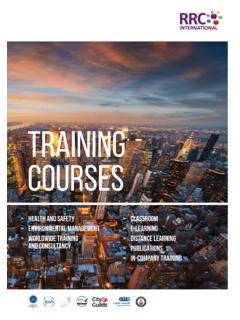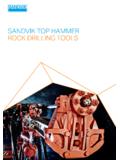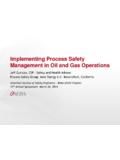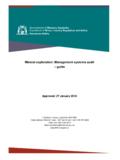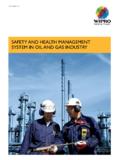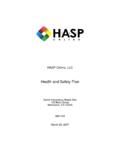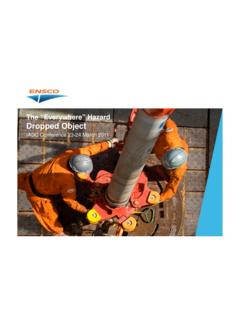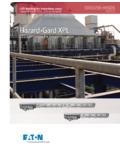Transcription of IOSH Working Safely MODULE 2: DEFINING …
1 RRC 27-37 St George s Road London SW19 4DS United KingdomT +44 (0)20 8944 3100 F +44 (0)20 8944 7099 Skype ID rrctrainingIOSH Working SafelyMODULE 2: DEFINING HAZARD AND RISKSAMpLE MATERIAL(Material correct Autumn 2013) RRC Training iosh Working Safely MODULE 2 | 2-1 MODULE 2: DEFINING Hazard and RiskIn the second MODULE of this course we will take a look at some basic health and safety principles to do with risk. We will look at possible sources of risk, how risk can be assessed and how it can be controlled. As we do this, there are some key words and phrases that we need to understand because they have quite specific meanings.
2 What is a Hazard?HazardSomething with the potential to cause examples of hazards include: A moving car on the road - if you are a pedestrian trying to cross that road. Electricity - running through the wires of your kettle or hair dryer. A sharp knife in the kitchen. The slippery floor of your bath or shower. An aggressive dog. Food poisoning bacteria - growing on a piece of chicken in a fridge. The oven cleaner - stored under the sink in the kitchen. Carrying the shopping out of the car and into your house. Kneeling on the floor banging nails into floorboards for three hours.
3 Fumes from a production process. A drilling machine. Work-related hazards are physical things that could cause harm because of their physical nature. In the above list, the car, dog, knife, slippery floor and electricity are all physical hazards. When using a drilling machine, it s possible to have a puncture wound from using the drill, or to get caught up in the rotating parts. These hazards are known as mechanical hazards. On the other hand, the oven cleaner is a chemical hazard. The food poisoning bacteria are a biological hazard and carrying the shopping and kneeling on the floor are activity hazards.
4 The fume generated in a production process can be an environmental hazard and organisational hazards occur when employees are subjected to bullying or harassment or even work-related stress when at work. These are known as non-mechanical we think about the types of harm that the hazards listed above could cause, it is clear that some would cause injury and some would cause ill-health or disease. For example, the food poisoning bacteria do not cause immediate injury; instead they cause sickness and diarrhoea 24 to 48 hours after you eat the contaminated piece of chicken.
5 That s an ill-health we turn our attention to the workplace, there are thousands of hazards that might and think for a moment about the things with the potential to cause harm in your workplace. A hazard is something with the potential to cause harm. Some hazards are obvious to everyone but some require prior knowledge to fully understand. Risk is the chance of someone coming into contact with a hazard (in combination with the consequences). Risk can be assessed by the process of identifying hazards, evaluating risks and identifying controls to avoid or minimise those risks.
6 Risk can be controlled by the introduction of workplace , Risk and Risk ControlRRC SAMPLE MATERIALIOSH Working Safely MODULE 2 | 2-2 RRC TrainingModule 2: DEFINING Hazard and RiskTypical examples of workplace hazards would include: Fire. Moving vehicles. Manual handling. Slip and trip hazards. Falling objects. Working at height. Noise. Chemicals. Biological agents. Electricity. Violence. Vibration. Dust. Poor posture. Exposure to HazardsIdentifying hazards is often easy since the hazards are obvious. In fact, you might say that it s just common sense.
7 However, in some cases, hazards can be difficult to identify unless you have prior knowledge. For example, carbon monoxide gas (also known as the silent killer ) is a colourless, odourless, tasteless gas which is lethal at low concentrations. It can t be detected by your senses and so you would first know of its presence when you start to suffer the symptoms of exposure (headache, nausea, drowsiness). Common sense won t help you here unless you have prior knowledge. Another hazard that is often not easy to see is dust. Asbestos is one of the most dangerous dusts; some fibres are so small we can t see them without a microscope, and inhaling these tiny fibres can be are various ways for identifying hazards in your workplace: Use your eyes and other senses.
8 Use other people s knowledge and experience. Look at the risk that last point - all workplaces have a legal obligation to carry out a risk assessment on their work activities. This risk assessment should clearly identify the significant hazards that workers and other people might be exposed the hazards associated with the use of a vacuum cleaner. On the next page you can check to see if you have spotted most of SAMPLE MATERIAL RRC Training iosh Working Safely MODULE 2 | 2-3 MODULE 2: DEFINING Hazard and RiskCommon hazards associated with the use of a vacuum the probability of injury from manual handling and noise may be considered as low they are both considered as SAMPLE MATERIALIOSH Working Safely MODULE 2 | 2-4 RRC TrainingModule 2: DEFINING Hazard and RiskWhat is Risk?
9 RiskThe chance of someone coming into contact with a hazard (in combination with the consequences).So, risk is the combination of two factors: Chance the likelihood that a person will come into contact with a particular hazard so that harm is caused. Consequence the foreseeable harm. How bad would it be?These two factors combine to give us the degree or level of risk. We might then identify the level of risk using words such as low risk or high risk . For example, a responsible adult making a cup of tea might be described as a low risk activity since they are unlikely to spill boiling water on themselves and, if they did, it is likely to be of little consequence since they will know to run cold water over the burn a 3-year-old child trying to do the same activity unaided might be described as a high risk since they are far more likely to spill boiling water over themselves and, if they did, the consequences are likely to be severe.
10 They don t know how to treat scalds and they can t reach the cold tap even if they wanted to. Exactly the same ideas are used in the workplace when thinking about , it s worthwhile pointing out that there is no such thing as zero risk ! No activity in life is risk-free. Everything that you do at work and at home exposes you to hazards that create risk. You can be killed or seriously injured by hazards in every room of your house, in your garden, or travelling to and from work. Work is no exception. Working Safely is not about creating a risk-free workplace since such a thing can t exist.


